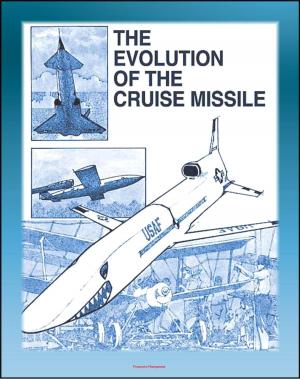Nanoscience and Nanotechnology for the Military: Defense Nanotechnology Research and Development Program, Nanotechnology for Future Force Armaments
Nonfiction, Science & Nature, Technology, Nanotechnology, Manufacturing| Author: | Progressive Management | ISBN: | 9781301251384 |
| Publisher: | Progressive Management | Publication: | May 30, 2013 |
| Imprint: | Smashwords Edition | Language: | English |
| Author: | Progressive Management |
| ISBN: | 9781301251384 |
| Publisher: | Progressive Management |
| Publication: | May 30, 2013 |
| Imprint: | Smashwords Edition |
| Language: | English |
Two important documents from the U.S. Defense Department provide a good overview of current military nanotechnology: Nanotechnology for Future Force Armaments, and Defense Nanotechnology Research and Development Program. Nanotechnology research remains a major national initiative, and DoD remains at the forefront as a major contributor—as it had been even before the inception of the formal NNI. Although great scientific and technological progress has been made, many questions about the behavior of matter at the nanoscale level remain, and considerable scientific knowledge has yet to be learned. Nanotechnology must still be considered to be in its technological and engineering infancy. Some significant applications have been noted, but these applications are viewed as just the beginning of an age of practical products based on nanomaterials and nanoprocesses. The engagement of DoD in nanotechnology research will continue to be important in ensuring the optimum direction of ongoing research efforts and the optimum leveraging of this knowledge to advance warfighter and defense-related systems capabilities.
The current DoD nanotechnology programs represent a well-balanced and dynamic investment portfolio that addresses both near-term national security needs and long-term challenges. The DoD continues to view nanotechnology as one of the enabling technologies that should receive the highest level of corporate attention and coordination as described in the 2007 Department of Defense Research and Engineering Strategy. DoD 2010 plans include continuing, approximately stable support for the NNI Program Component Areas (PCAs) associated with the DoD mission. The primary PCAs will remain Fundamental Nanoscale Phenomena and Processes, Nanoscale Devices and Systems, and Nanomaterials. New projects in nanotechnology, as in all thematic areas, are awarded on a competitive basis, so the actual balance of investment may vary somewhat from current expectations.
Contents: The United States Air Force * 1. Air Force Devices and Systems * Photon-Plasmon-Electron Conversion Enables a New Class of Imaging Cameras * 2. Air Force Nanomaterials * Processing of Explosive Formulations With Nano-Aluminum Powder * 3. Air Force Manufacturing * Uncooled IR Detector Made Possible With Controlled * Carbon Nanotube Array * Nanoparticle Lubricant Produced by Biosynthesis * B. The United States Army * 1. Army Fundamental Phenomena * Photonics * Piezoelectric Sensing * Enhanced Thermoelectric Properties * 2. Army Nanomaterials * Improved Polymer Composite * Chemical Sensing/Decontamination * 3. Army Devices and Systems * Magnetic Resonance Force Microscopy * Air-Activated Heaters * C. The United States Navy * 1. Navy Fundamental Phenomena and Processes * Electronics * Fundamental Thermal Properties * Nanostructure-Enhanced Thermoelectric Properties * 2. Navy Nanomaterials * Magnetics * Semiconductors * 3. Navy Devices and Systems * Spin-Based Devices * Energy Storage * 4. Navy Instrumentation/Metrology/Standards * Mechanical Property Variation * 5. Navy Nanomanufacturing * Cost Saving * D. The Defense Advanced Projects Research Agency (DARPA) * 1. DARPA Fundamental Phenomena * 2. DARPA Manufacturing * E. The Defense Threat Reduction Agency (DTRA) * 1. DTRA Chem/Bio (CB) Defense Functional Nanostructures * 2. DTRA CB Defense Biomimetric Design Rules * 3. DTRA CB Defense Nanoscale Platforms * 4. DTRA CB Hazard Mitigation * 5. DTRA CB Integrated Protective Fabric * 6. DTRA CB Novel Filtration Methods Without Expendable Media * V. Funding * VI. Coordination Activities * VII. DoD Implementation of Triennial Review Recommendations * VIII. Assessment of Technology Transition * IX. Assessment of Small Business and Manufacturing Technology Contributions and Transitions * X. Acquisition Program and Program Office Status * XI. Global Research Activities * A. Nanotechnology: China
Two important documents from the U.S. Defense Department provide a good overview of current military nanotechnology: Nanotechnology for Future Force Armaments, and Defense Nanotechnology Research and Development Program. Nanotechnology research remains a major national initiative, and DoD remains at the forefront as a major contributor—as it had been even before the inception of the formal NNI. Although great scientific and technological progress has been made, many questions about the behavior of matter at the nanoscale level remain, and considerable scientific knowledge has yet to be learned. Nanotechnology must still be considered to be in its technological and engineering infancy. Some significant applications have been noted, but these applications are viewed as just the beginning of an age of practical products based on nanomaterials and nanoprocesses. The engagement of DoD in nanotechnology research will continue to be important in ensuring the optimum direction of ongoing research efforts and the optimum leveraging of this knowledge to advance warfighter and defense-related systems capabilities.
The current DoD nanotechnology programs represent a well-balanced and dynamic investment portfolio that addresses both near-term national security needs and long-term challenges. The DoD continues to view nanotechnology as one of the enabling technologies that should receive the highest level of corporate attention and coordination as described in the 2007 Department of Defense Research and Engineering Strategy. DoD 2010 plans include continuing, approximately stable support for the NNI Program Component Areas (PCAs) associated with the DoD mission. The primary PCAs will remain Fundamental Nanoscale Phenomena and Processes, Nanoscale Devices and Systems, and Nanomaterials. New projects in nanotechnology, as in all thematic areas, are awarded on a competitive basis, so the actual balance of investment may vary somewhat from current expectations.
Contents: The United States Air Force * 1. Air Force Devices and Systems * Photon-Plasmon-Electron Conversion Enables a New Class of Imaging Cameras * 2. Air Force Nanomaterials * Processing of Explosive Formulations With Nano-Aluminum Powder * 3. Air Force Manufacturing * Uncooled IR Detector Made Possible With Controlled * Carbon Nanotube Array * Nanoparticle Lubricant Produced by Biosynthesis * B. The United States Army * 1. Army Fundamental Phenomena * Photonics * Piezoelectric Sensing * Enhanced Thermoelectric Properties * 2. Army Nanomaterials * Improved Polymer Composite * Chemical Sensing/Decontamination * 3. Army Devices and Systems * Magnetic Resonance Force Microscopy * Air-Activated Heaters * C. The United States Navy * 1. Navy Fundamental Phenomena and Processes * Electronics * Fundamental Thermal Properties * Nanostructure-Enhanced Thermoelectric Properties * 2. Navy Nanomaterials * Magnetics * Semiconductors * 3. Navy Devices and Systems * Spin-Based Devices * Energy Storage * 4. Navy Instrumentation/Metrology/Standards * Mechanical Property Variation * 5. Navy Nanomanufacturing * Cost Saving * D. The Defense Advanced Projects Research Agency (DARPA) * 1. DARPA Fundamental Phenomena * 2. DARPA Manufacturing * E. The Defense Threat Reduction Agency (DTRA) * 1. DTRA Chem/Bio (CB) Defense Functional Nanostructures * 2. DTRA CB Defense Biomimetric Design Rules * 3. DTRA CB Defense Nanoscale Platforms * 4. DTRA CB Hazard Mitigation * 5. DTRA CB Integrated Protective Fabric * 6. DTRA CB Novel Filtration Methods Without Expendable Media * V. Funding * VI. Coordination Activities * VII. DoD Implementation of Triennial Review Recommendations * VIII. Assessment of Technology Transition * IX. Assessment of Small Business and Manufacturing Technology Contributions and Transitions * X. Acquisition Program and Program Office Status * XI. Global Research Activities * A. Nanotechnology: China















